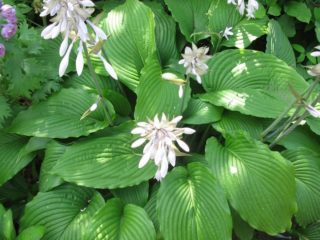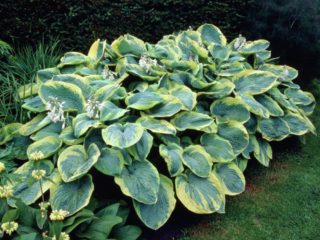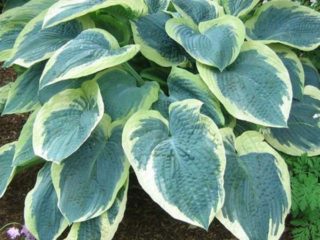Content
Khosta Siebold is an amazingly beautiful perennial plant. It is ideal for decorative landscaping of a garden, personal plot, as well as for lawns and coastal areas of water bodies.
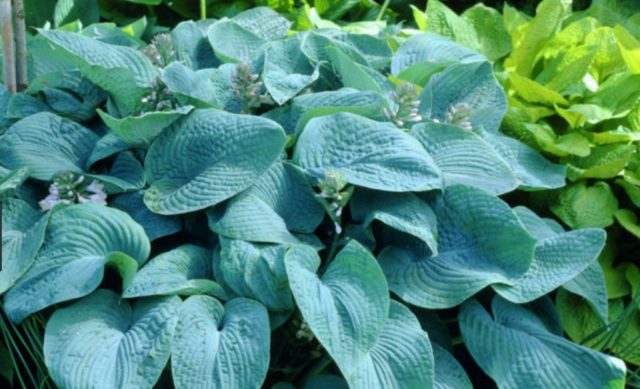
Khosta Siebold has an unusual appearance due to textured large leaves
Description of Siebold hosts
The hosta garden plant is a perennial and belongs to the Asparagus family. Japan (the island of Honshu) is considered to be the homeland, where this plant can be found in the wild, in addition, it is in the Far East and in East Asia. The host Siebold received its name in honor of the botanist and explorer Philip Siebold. For the first time, the plant was brought to Europe in the XIIX-XIX centuries. Today, hosta is used everywhere to decorate flower beds, a bed in personal plots, and bushes are also planted around ponds, at the base of alpine hills, in other areas where many plants do not take root well.
The first 2 years after the planting of the Siebold host develops slowly, but for 3-4 years its growth accelerates. In the same period, a seasonal change in the color of the leaves begins. The plant begins to show its decorative qualities by the age of 4, and by the age of 8-10 it fully reveals its magnificence.
In appearance, the shrub is rather large with wide and dense leaves. Their color is deep green with a gray waxy bloom, heart-shaped. Due to the fact that the color has a bluish-gray tint, the plant is referred to as blue hosts. The surface of the sheet is ribbed to the touch, it is about 30 cm long and up to 25 cm wide.
Hosta Siebold blooms in early July, inflorescences are practically invisible behind large greenery. The peduncles themselves reach a height of no more than 40 cm, practically have no leaves, flowers of a light lilac shade, funnel-shaped or bell-shaped in shape. At the end of flowering, small triangular boxes with black seeds inside ripen on them. The rhizome is compact, short and has few branches.
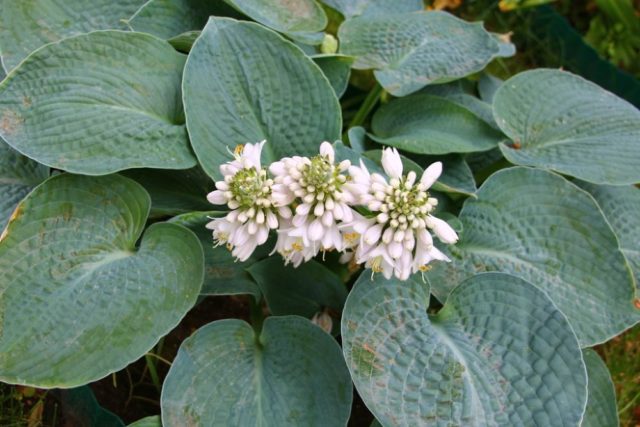
In length, the peduncles reach 6 cm and their top is abundantly crowned with pale lilac flowers
The plant itself is unpretentious in care and has a fairly high degree of winter hardiness. Calmly withstands frosts down to -35 degrees without shelter.
Khosta Siebold belongs to shade-loving plants, but at the same time it can grow in a clarified area, provided that direct sunlight falls on it for no more than 1-2 hours a day. With prolonged exposure to the scorching sun, the leaves will not have a bluish bloom, but will turn dark green.
Application in landscape design
Khosta Siebold is considered a versatile plant in landscape design. It is used both to create independent compositions and in combination with other colors.
It looks great in a flower bed with various ground cover and undersized plants (daylily, viola, primrose, berserk, daisies). Often, compositions are planted, where such plants take root well together with the host:
- prima;
- sedum (sedum);
- fern;
- iris;
- spurge;
- corydalis;
- thuja;
- bells;
- peonies.
And this is not the whole list of suitable plants for joint planting with the Siebold host.It also goes well with conifers and cereals.
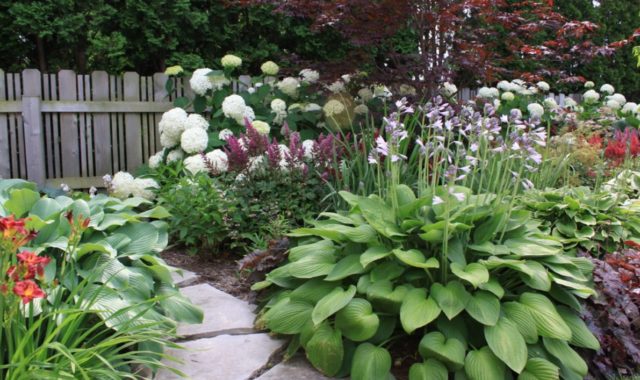
Hosta Siebold in a successful garden arrangement with various flowers
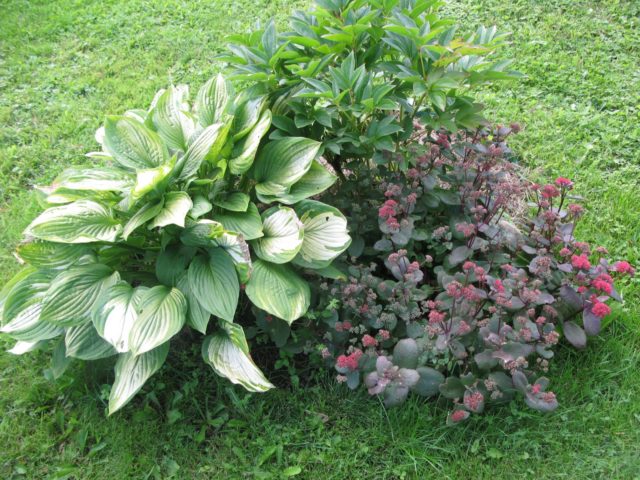
Small flower bed with sedum and peonies
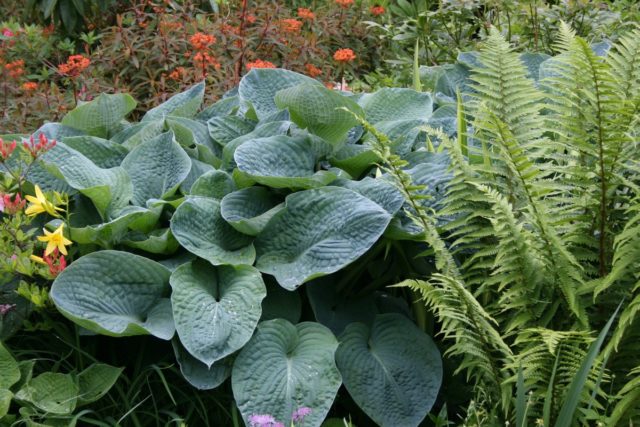
Hosta Siebold Elegants in combination with fern against the background of flowering bright plants
Varieties
Siebold's host has several varieties. The most popular hybrid varieties of this plant were developed in Japan. They differ in height, as well as in the size of the leaves.
Francis Williams
Khosta Siebold Frances Williams is unpretentious, frost-resistant and suitable for growing on all types of soil. High resistance to various diseases was also noted.
The plant of this variety is recommended for planting in partial shade, while the place must be protected from the wind, as large leaves can be damaged.
According to the description of the host Siebold, Francis Williams is a medium-sized perennial shrub, reaching 65 cm in height. The leaves are large, rounded, azure-blue with a yellow border around the edges.
Blooms in mid-summer (June-July), short stalks with white flowers. Their diameter is up to 5 cm, they form brushes of 8 pieces.
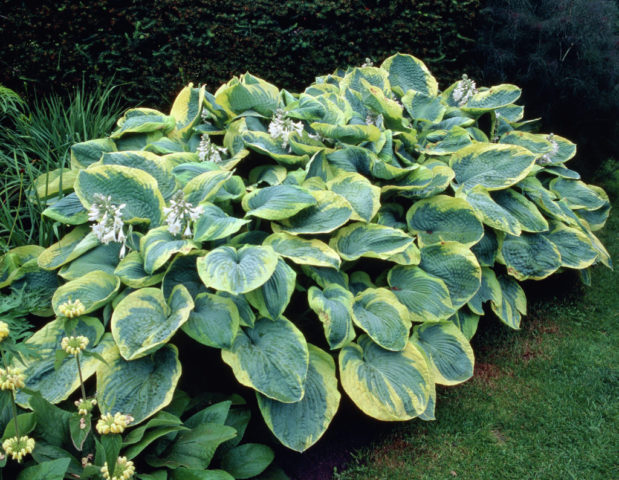
The leaves have an attractive two-tone color.
Elegans
The host of Siebold's Elegance is rather large. The bush can grow up to 70 cm in height. The leaves are also quite large with a bubbly surface. The length of the plate can be about 36 cm.
The plant grows slowly, but with age, the size of the leaves and their ribbing increase.
Hosta elegans differs from other varieties in early flowering (at the end of June). The inflorescences are compact, located on a peduncle, which is almost level with the leaves in height. The flowers are white with a slight lilac tint, waxy to the touch.
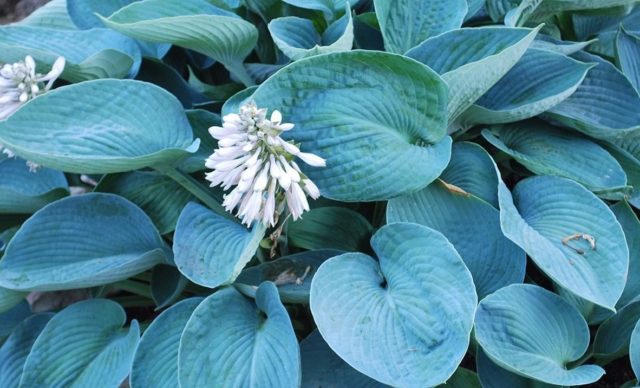
Khosta Siebold's Elegance is a very spectacular garden plant that surprises with its size
Vanderbolt
Khosta Siebold Vanderbolt (Thunderbolt) has an amazing color of the leaves. Their shape is heart-shaped, they themselves have a velvet-blue hue, as well as a creamy feather-like stripe in the center. It should be borne in mind that such a color of the leaves of this variety will only be in the shade and partial shade, they turn green in the sun, and the central cream strip burns out strongly.
Flowering occurs in mid-summer. The inflorescences are voluminous due to large bell-shaped white flowers.
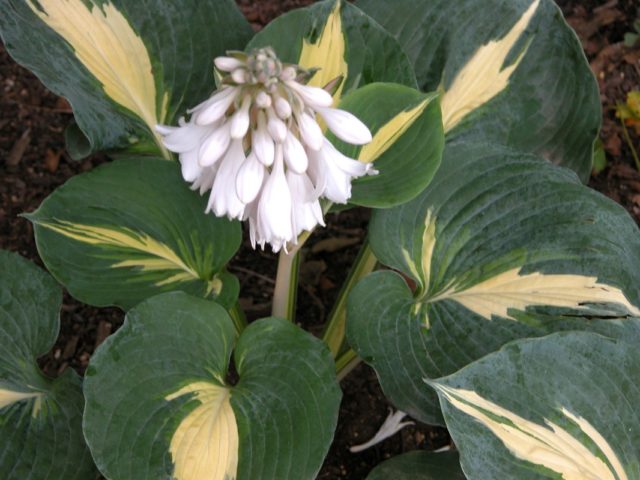
Over time, the creamy stripe in the center of the leaf turns white
Golden Meadows
The Siebold Golden Meadows hosta variety has dense, tough leaves, large in size and with a wavy edge. The color is contrasting, the core has a cream shade, and the border is gray-green. The variety is valued for the variability of the color of the center of the leaf plate, which has a golden hue in spring, cream in summer, and becomes greenish closer to autumn.
The bush itself is medium in size, reaching a height of 60 cm. Grows moderately. Flowering occurs in July.
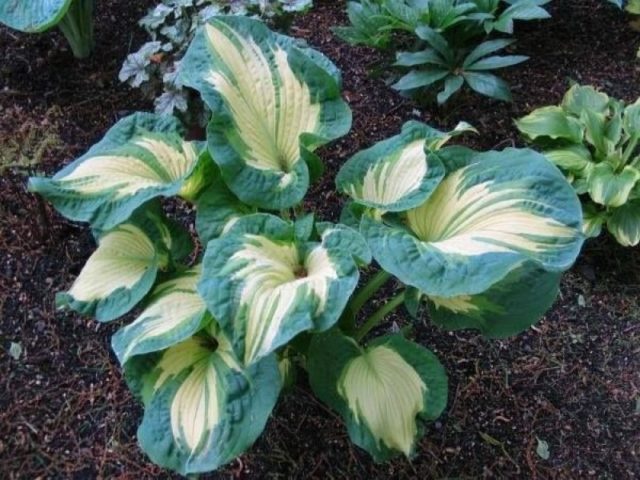
The variety is distinguished by rolling leaves that can change color.
Hercules
The Hercules variety belongs to hybrid giant plants. The leaves are rather large, heart-shaped, with a dark green color and a slightly bluish tint, glossy. Veins are longitudinal, closely spaced. White flowers look spectacular against the background of dark leaf plates.
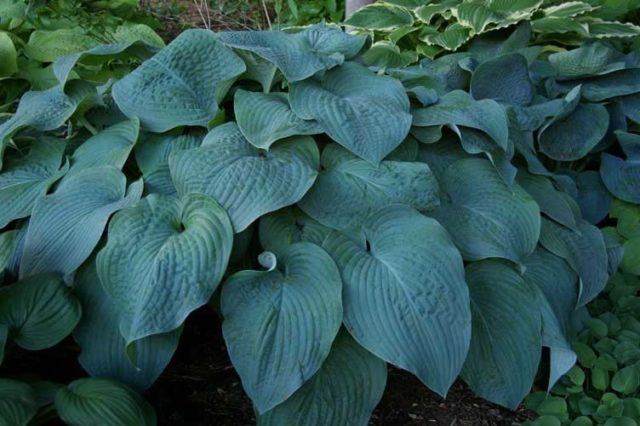
It grows relatively quickly and can reach a height of 75 cm
Semperaurea
Plant Khosta Siebold Semperaurea, which in Latin - Semperaure, is distinguished by slightly narrowed medium-sized leaves with a yellow-green tint.
The height of the bush is no more than 65 cm. Grows moderately.

Due to the light yellowish leaves, this variety looks contrasting against the background of green plants.
Breeding methods
The simplest, most effective and at the same time the fastest way of breeding the Siebold hosts is by dividing the bush. This method is suitable for absolutely all plant varieties and allows you to preserve all the qualities of the mother bush.Naturally, the seed method of propagation is also practiced, but, as a rule, not all plants can set seeds, and the seedling as a result does not retain its varietal characteristics.
Landing algorithm
Khosta Siebold differs from many other garden plants in the later period of the growing season, for this reason the planting time is not clear-cut. Can be planted both in late spring and early autumn.
The plant itself is shade-loving, which must be taken into account when choosing a place. A plot on the north side of the house or under the shade of trees is ideal.
The soil should be fertile, loamy, breathable and moisture-absorbing. Too damp and swampy areas are not the best place to plant.
Siebold's seedlings should also be chosen carefully. As a rule, a healthy plant should have a well-developed root system of at least 10 cm. Be sure to inspect for the presence of buds in a young specimen, their number is 3-4 pcs.
The landing algorithm consists of the following actions:
- First, they prepare the soil, dig up and loosen it. Then they make rather wide indentations, be sure to keep the distance between the plants, because the bush can reach up to 80 cm.
- A small amount of humus is poured at the bottom of each hole, and a small amount of peat is added to the soil to increase air permeability.
- Be sure to form drainage. This layer can be made of perlite.
- Next, a little water is poured into the recess and a seedling is placed in it. Fall asleep with soil, lightly tamp.
- A layer of mulch is poured around the trunk circle.
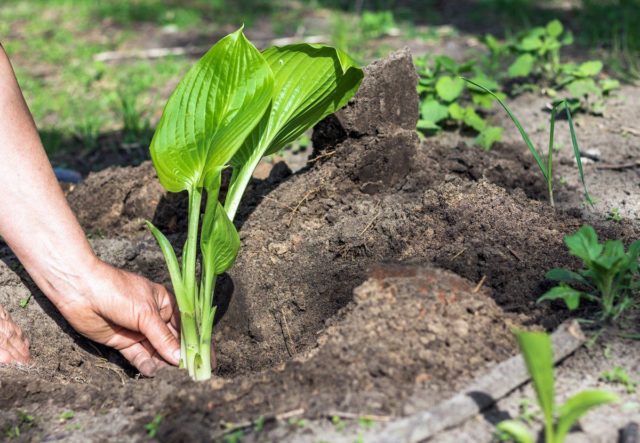
The ideal time to plant hosts in open ground is 6 pm, when there is no risk of direct sunlight
Growing rules
The rules for growing Siebold's hosts are almost identical with the cultivation characteristics of other garden plants.
Among the most basic care requirements are the following:
- Watering is carried out at least 1 time in 1-2 days. It is performed in the morning so that by the evening the bush and the soil will dry out. Water must be poured under the root of the plant, since the leaves have a protective waxy layer that can be washed off over time, which should not be allowed. Water abundantly: for 1 bush 10-30 liters of water, depending on age.
- It takes about 2-4 times to feed the Siebold host during the summer. The amount of dressing directly depends on the age and size of the bush. As a rule, compost, rotted manure, peat are best used as organic fertilizers. At the same time, organic feeding is often combined with mineral components. Perform it only after rain or abundant watering.
- Many gardeners recommend cutting the peduncles at the end of flowering so that the plant does not waste energy on seed formation.
- Preparing for winter
Siebold's host has a fairly high degree of frost resistance, so there are no special requirements for preparation for winter. The main rule of autumn care is pruning dead leaves, which must be removed. The plant does not need shelter, with the exception of young specimens of the first year of life.
Diseases and pests
The most common host disease is the HVX virus, which spreads only to this plant species. The disease is characterized by the appearance of spots on the leaf plates that shine through in the sun. Infection occurs through the sap of the plant, therefore, after cutting the infected leaves, the instruments must be disinfected.
With improper care, root collar rot can develop.A diseased plant is treated by digging it up, cutting off the affected part, processing and subsequent transplantation to a new place.
Among the pests, the most dangerous are slugs and caterpillars. Leaves can be prevented by mulching with needles, sawdust. If pest attacks have become more frequent, it is recommended to carry out an insecticide treatment.
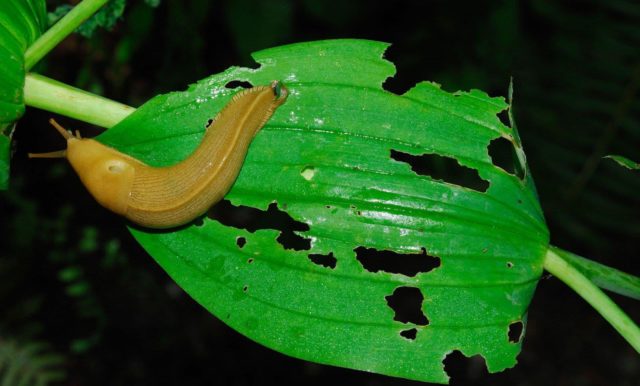
Slugs are especially dangerous for young and thin-leaved hosts.
Conclusion
Khosta Siebold is a real find for keen gardeners. The plant is unpretentious, tolerant to lack of light and is suitable for planting where many garden crops take root with difficulty.
